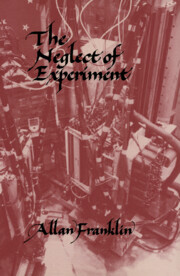Book contents
- Frontmatter
- Contents
- Acknowledgments
- List of abbreviations
- Introduction
- 1 The discovery of parity nonconservation
- 2 The nondiscovery of parity nonconservation
- 3 CP or not CP
- 4 The role of experiment
- 5 Do experiments tell us about the world?
- 6 The epistemology of experiment
- 7 The epistemology of experiment: case studies
- 8 Forging, cooking, trimming, and riding on the bandwagon: fraud in science
- Conclusion
- Notes
- Index
2 - The nondiscovery of parity nonconservation
Published online by Cambridge University Press: 15 December 2009
- Frontmatter
- Contents
- Acknowledgments
- List of abbreviations
- Introduction
- 1 The discovery of parity nonconservation
- 2 The nondiscovery of parity nonconservation
- 3 CP or not CP
- 4 The role of experiment
- 5 Do experiments tell us about the world?
- 6 The epistemology of experiment
- 7 The epistemology of experiment: case studies
- 8 Forging, cooking, trimming, and riding on the bandwagon: fraud in science
- Conclusion
- Notes
- Index
Summary
In the previous chapter we mentioned two earlier experiments, performed by Cox, McIlwraith, and Kurrelmeyer, “Apparent Evidence of Polarization in a Beam of β-Rays,” and by Chase, “The Scattering of Fast Electrons by Metals. II. Polarization by Double Scattering at Right Angles,” that, at least in retrospect, provided evidence for nonconservation of parity in the weak interactions. The anomalous nature of those experimental results seems to have been fairly well known (we shall discuss this later), although the exact nature of the anomaly was not clear. However, one thing is certain: The relation of those results to the principle of conservation of parity was not recognized or understood by any contemporary physicists, including the authors themselves. Before discussing the reasons leading to this conclusion, it is worth examining in some detail what those results were, how they were obtained, and whether or not they really provided evidence for nonconservation of parity.
DID THE EXPERIMENTS SHOW NONCONSERVATION OF PARITY?
The intellectual context for those experiments involved the desire to demonstrate the vector nature of electron waves. This had started with the suggestion of de Broglie in 1923 that just as light exhibited both particle and wave characteristics, so should those things that we normally consider particles exhibit wave characteristics. This had been brilliantly confirmed in 1927 in an experiment on the diffraction of electrons by crystals performed by Davisson and Germer. This idea of electron waves was then combined with the concept of electron spin, which had been used by Uhlenbeck and Goudsmit to explain certain features of atomic spectra.
- Type
- Chapter
- Information
- The Neglect of Experiment , pp. 39 - 72Publisher: Cambridge University PressPrint publication year: 1986



